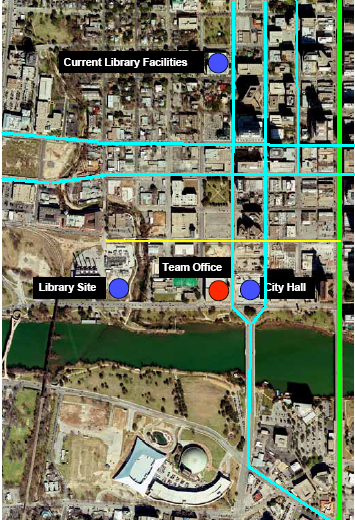Thanks to the precedent set by the Shoal Creek debacle, doctor this web yet another neighborhood has agitated for, and won, parking in bike lanes. From the Chronicle’s piece:
The stated policy of the city’s bicycle program is to implement no-parking zones for bike lanes when streets are scheduled for maintenance and restriping – which is now the case between Westover and Windsor roads on Exposition. City staff’s recommendation, however, includes allowing parking in bike lanes overnight beginning at 7pm on certain segments, at all times except two three-hour commuting windows on others, and on Sundays on one stretch to accommodate church parking.
At least they expressed the view of the Leage of Bicycling Voters pretty well:
On Tuesday, LOBV President Rob D’Amico said, “The idea of a bike lane is to promote safe bicycle travel at all times … especially at night when riding is most dangerous.”
That is the only sensible view, people. We don’t park cars in (normal) traffic lanes (streets with on-street parking have either marked parking or unmarked lanes – the latter being the case on residential streets where most parking occurs). We shouldn’t park cars in bike lanes either. And as Rob D’Amico points out, nighttime is the time you need the bike lanes the most.
Exposition isn’t a residential street. It’s an arterial roadway – the road all those people go to from the residential streets (and collectors). Even though it has some residences on it, “residential street” has a very distinct meaning here, and Exposition is not one but TWO classifications higher on the food chain. If visitors to these churches or to the residences on Exposition are having trouble finding enough parking, there are options available a short walk away which don’t require that we risk cyclists’ lives.
I don’t envy city staff – who knows what the right thing is to do and yet has to defend this ridiculous policy decision anyways. Place your blame squarely at the foot of city council members who would rather pander to the selfish interests of neighborhood reactionaries than take a stand for public safety (or, even, a stand for parking – marked on-street parking spaces on Exposition without bike lanes would at least be a consistent and reasonable traffic marking).
You might have wondered why I haven’t written about the efforts by Capital Metro to claim their commuter rail service is “light rail” now that the FRA is giving them much more trouble than anticipated with their regulatory oversight. The answer is that I’ve been slammed by the worst bout of Austin allergies yet, page and have had to marshal my diminished concentration on the day job. Important excerpts, visit this site since the Statesman’ news site will probably age this off before too long:
After all, practitioner supporters of the plan said, it won’t be powered with electricity, like most light-rail systems, but rather with diesel engines like commuter rail. It will originate 32 miles away in the suburbs and haul in commuters. The stops would generally be far apart, especially those first few out northwest. This is not light rail, they said. I eventually bought into all this, becoming a bit of a prig about correcting people who called it light rail.
[…]
Turns out that dubbing it commuter rail meant, at least to Uncle Sam and in conjunction with the freight hauled on the same track, that regulation of the line falls under the auspices of the Federal Railroad Administration, not the Federal Transit Administration. And that first agency’s rules for running a passenger train on a line that also has freight trains — albeit at different times of the day or night under Capital Metro’s plan — have much tougher standards for the track control system and the construction of the cars. Capital Metro has been trying for more than two years to get the railroad agency to say yes to its plan, a final nod it has yet to secure.
Earlier this year, Capital Metro tried to change referees, petitioning to have the transit administration take over and waive certain requirements. In pursuit of that effort, Capital Metro chief Fred Gilliam wrote a letter May 22 to James Simpson, administrator of the transit agency.
“Our MetroRail project is clearly an urban rapid transit or light rail system,” he wrote. It was “initially” referred to as urban commuter rail, he said, “to avoid confusion with an earlier proposal that involved electric vehicles.” You know how confused voters can get
I’ve been too overwhelmed with that allergy attack to focus enough to write a good piece, but I couldn’t wait any longer, especially after they posted this on their blog. Here’s my response in their comment section:
This is a misleading article. Nearly nothing in traditional light rail lines would apply to starting DMU service on an existing freight line, and to say that 8 of the 9 stations are within Austin is also incredibly misleading as the two northernmost, the ones that actually have parking, are right on the edge of the city limits and expected to serve primarily non-residents. The remaining “Austin” stations are largely for drop-offs only, and have hardly any residential development within walking distance.
This is a sharp contrast to the 2000 light rail route – which served the same suburban constituencies but also served central Austin.
There’s really nothing urban OR light about this line. It’s standard commuter rail – buy trains and stick them on freight tracks. Period. Just because the FRA gives you trouble is no reason to join Lyndon Henry’s brigade of serial misinformation artists.
In a second comment, I add:
The other key difference, of course, is that a “light railway” could easily be brought straight to UT, the Capitol, and right down the heart of downtown – like that 2000 route does. Our commuter rail vehicles will never be able to do any of those things – they are designed to run on freight railways and cannot make turns that would be necessary to run on anything like a normal light rail route through a true urban area. As a result, essentially every single passenger that rides this thing will be forced to transfer to a shuttle-bus at the work end of their trip. You can’t get any farther away from the idea of light rail than that.
By the crappy arguments promoted by agents of misinformation like the aforementioned Lyndon Henry, if we bought a DMU and ran it in between freight traffic on the UP line that runs down Mopac, that would, too, magically turn into a “light railway”. Of course that’s complete and utter bullshit – everybody knows what ‘light rail’ is – it’s rail and vehicles that can be run through cities without having to demolish a bunch of buildings to make turns, and that doesn’t have to maintain compatibility with freight traffic.
You can expect more from me when I feel better – I need to focus my periods of concentration on my real job in the meantime, but don’t buy this nonsense – it’s NOT light rail – it’s a standard, stupid, shuttle-bus-dependent commuter rail service, even if they do what they’re claiming they might and add a bunch more stations because it will never be capable of running to UT, the Capitol, or even turning downtown to make it to Seaholm. It’s still fundamentally a freight rail line, and the trains we bought are designed to run on freight railways with long turns.
And, my email to our city council:
Please be aware that the decision by Capital Metro to attempt to rebrand (at this late date) their commuter rail service as “light rail” in a desperate attempt to avoid FRA oversight is not supportable by the facts. By their flimsy arguments, if we somehow got Amtrak to increase frequency a bit on the UP line, it would magically turn into a “light railway”.
What we’re building is standard-issue commuter rail (service started on the cheap that only runs on existing freight tracks – and uses vehicles incapable of navigating the turns it would have to take in central Austin to get anywhere worth going without transferring to shuttle buses).
I hope those of you who are board members will disabuse Capital Metro of the notion that simply calling it “light rail” makes it so. It’s still an awful commuter rail service that barely serves Austin at all and can never take passengers to any major destinations without a ridership-killing transfer at the work end of their journey. The city of Austin would be best served by continuing down the path undertaken by the CAMPO TWG which is an actual urban rail system that can and will serve Austin residents in a way commuter rail can never do.
Regards,
Mike Dahmus
Capital Metro has now gone to moderation on comments at their blog, visit this after posting this followup to yesterday’s trial balloon on the “it’s light rail because we say so” front. (Update: Erica says in comments here that they went to moderation because of a nasty personal attack – I have no reason to believe otherwise; they have posted everything I’ve written, viagra so far).
Here’s what I commented to that post:
LRT was actually projected to have ridership in the mid 30s with the minimal operable segment (in 2007); and that was before some major developments have come online (like the Triangle).
Adam, 2000 per day is pathetic. So is the RiverLine’s 9000 per day. And the RiverLine was only able to operate that ‘well’ with those DMUs because they condemned a bunch of corners in downtown Camden in order to run directly to their CBD rather than to one far edge, then relying on shuttle buses for the “last mile”.
We don’t have the ‘luxury’ of a downtown so blighted that it’s no big deal to take corners of blocks here and there to run a porky DMU instead of a true light rail vehicle – which is why our commuter rail line is such a dead end – it can never and will never go to UT, the Capitol, and most of downtown.
Update: They’re really getting desperate over there. Follow the link, and here’s my comment for posterity:
Essentially nobody else other than the agencies in question would consider New Jersey’s service to be “light rail” either. So that’s not really going to convince anybody. They called it “light rail” for the same reason Lyndon Henry’s been doing it – to try to capitalize on the favorable brand image of LRT with people who have had good experiences on true light rail in other cities.
If you were going to bold something, how about this paragraph:
In the meantime, the best strategy for any transit agency interested in developing a shared-use project is to follow FRA’s policy advice and meet with FRA as soon as possible. Ideally, this should be done during the project definition phase and no later than the beginning of preliminary engineering. Transit agencies should recognize the FRA’s broad regulatory authority over shared-use rail transit projects and focus more on obtaining a jurisdictional determination that is compatible with their project mission. The critical shared-use issue for transit agencies to be concerned with is not the FRA’s regulatory authority over shared-use operations. It is the FRA’s jurisdictional determination process and how it relates to defining your project as light rail or commuter rail.
(I’m making a full post about this because I’m tired of having to dig up the links from comments; this is primarily for background for future postings).
Pictures from Camden, healthful NJ, infection on the RiverLine, this site which is also inappropriately labelled “light rail” by the same people trying to mislead you about our starter line here in Austin:
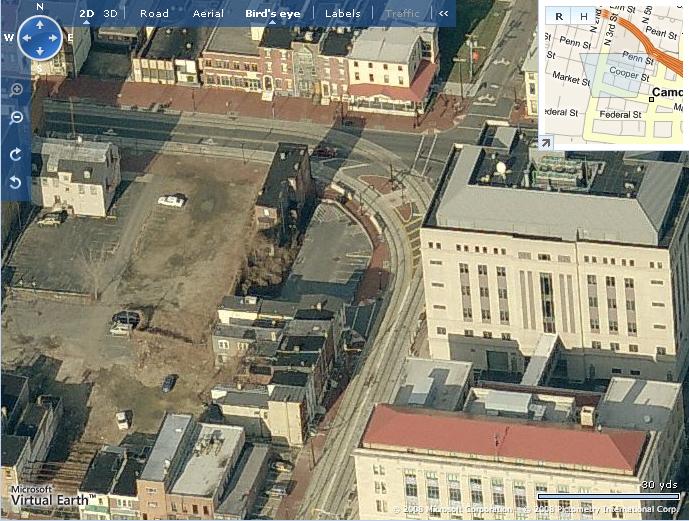
Doesn’t look so bad. Just a bit of a corner, right? Keep going.
Further down the street to the south (down in the first image):
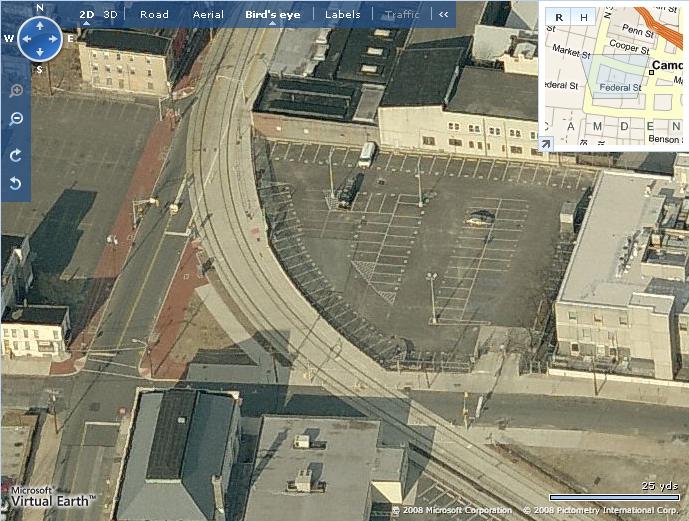
Further:
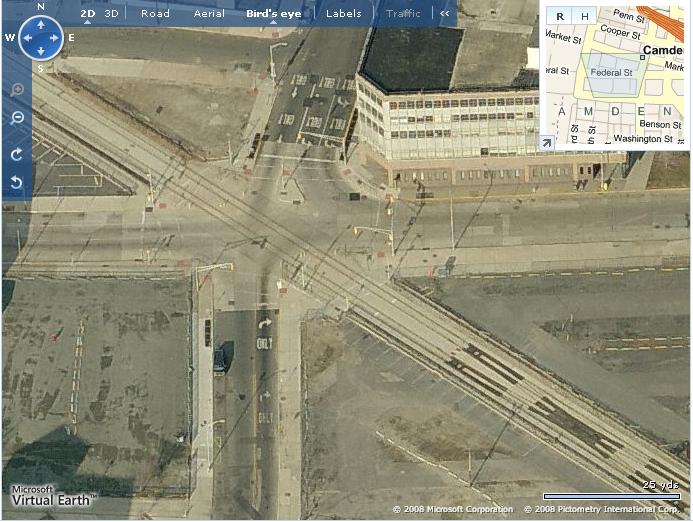
Try it yourself – click on any one of those images and then drag to navigate along the supposed “light” railway – and see how they managed to get it into the city core.
Any questions? This isn’t light rail – it’s a freight rail line bulldozed through a bunch of city blocks; which we don’t have the latitude to do here in Austin, since our downtown blocks actually have some economic value.
In all this talk about the bailout, tooth how many times have you heard anybody serious in political circles say that we ought to be paying the bill for this with a tax hike on high incomes? Zero? Less than zero? Wouldn’t a conversation about making sure those who benefitted the most from the runup and will benefit most from the bailout pay most of the bill happen in any adult country?
The guys who made all the money, then crashed the financial system, and will be getting bailed out are, actually, apparently set to get a tax break with the AMT and capital gains tax changes being proposed. That’s just seriously regressive no matter how you slice it – we’re apparently either going to pay for this via inflation or via general tax hikes on everybody.
My former cow-orker and I still trade predictions every week or two on whether we’ll be seeing deflation or inflation as a result of all this, but now the rest of you get to share in my brilliance. I’m probably the last crackplogger in America to talk about the financial collapse. Yay!
Or, capsule “M1EK is a downtown-hating car-loving sprawlmonger. Wait, approved what?”
Because I pointed out that most people won’t walk 7 blocks each way from a transit stop to get to their office, among other things, a commenter at the Statesman thinks I’m one of those folks who:
drive[s] around the parking lot at HEB for hours trying to find a good close-in spot. Maybe take a handicap spot if it’s REAL HOT…
and:
Your about to tell me that no one is going to move into those condos and they built too many. Maybe you should do a little looking into that statement before you bore us with it. Every condo built so far has been sold an there’s a waiting list big enough to fill 85% of the ones not done yet. I know because I looked into it, because obviously. I don’t mind walking around downtown.
Go there for the full experience. Anybody who knows me will have diet coke coke shooting out their nose. (Although, for one thing, I can go straight to the handicapped space at HEB, thanks, for the same reason I don’t ride my bike anymore).
Good lord. This is almost, but not quite, as funny as the Tahoe-haver label I got from another cyclist back in the day. Yee-haw!
Best Urban Development Echo Chamber with Chris Bradford, advice the Austin Contrarian, and Shawn Shillington from the Austinist (they pulled off the hat trick).
Thanks, Wells. And it was nice to meet you and Richard and the Austinist crew in person. Also congrats to Jason Abels, who I wish I’d have talked to more later, but never had a chance.
And as always, thanks to Baba for hosting this thing, which started after the ISP (I was actually paying!) turned out to not be backing up their mysql database.
I urge you to vote against Prop II for all the reasons elucidated in many other forums. But I find it interesting that some people who believed so strongly in the RG4N case have come down on (what I think is) the right side this time. Let’s play a little game. See if you can identify which group is which; one being RG4N and the other being “Stop Domain Subsidies”. Prize? Acclamation!
| Group A | Group B |
|---|---|
| Co-opting supposed grass roots to fight against decision of city council they didn’t like | Co-opting supposed grass roots to fight against decision of city council they didn’t like |
| Angry that city hired outside legal counsel to advise and defend previous city actions / ordinances | Angry that city hired outside legal counsel to advise and defend previous city actions / ordinances |
| Defending traditional strip retail against a marginally better project | Defending traditional strip retail against a marginally better project |
| Painting themselves as the ‘citizens’ in a ‘citizens versus corporations’ battle | Painting themselves as the ‘citizens’ in a ‘citizens versus corporations’ battle |
| Asserting that city staff is somehow bought off or otherwise subrogated because they published professional opinion which hurt Group A’s case | Asserting that city staff is somehow bought off or otherwise subrogated because they published professional opinion which hurt Group B’s case |
| Blithely asserting that the city staff and outside lawyers are wrong, therapy while the citizen group with no actual experience in land use or law must be right | Blithely asserting that the city staff and outside lawyers are wrong, click while the citizen group with no actual experience in land use or law must be right |
| Pushing for change that, if they won, would get city sued, and beaten | Pushing for change that, if they won, would get city sued, and beaten |
| Claiming to be progressive, yet primary obvious goal is to prevent change | Claiming to be progressive, yet primary obvious goal is to prevent change |
I’m sure there’s more, but with this many key differences, I’m sure somebody can pick out which group is Responsible Growth for Northcross and which one is Stop Domain Subsidies. Good luck!
By the way, kudos to the Chronicle for posting their endorsement background. It’s actually good stuff – I wish we had more dialogues of that quality.
Penn State isn’t Ohio State. Or Michigan, pathopsychology for that matter.
Colors in honor of current #1 and #2. Take that, thumb Aggees!
| SEASON | BOWL | RESULT |
|---|---|---|
| 2007 | Alamo | Penn State 24, phthisiatrician Texas A&M 17 |
| 2006 | Outback | Penn State 20, Tennessee 10 |
| 2005 | Orange | Penn State 26, Florida State 23 (3 OT) |
| 2002 | Capital One | Auburn 13, Penn State 9 |
| 1999 | Alamo | Penn State 24, Texas A&M 0 |
| 1998 | Outback | Penn State 26, Kentucky 14 |
| 1997 | Citrus | Florida 21, Penn State 6(*) |
| 1996 | Fiesta | Penn State 38, Texas 15 |
| 1995 | Outback | Penn State 43, Auburn 14 |
| 1994 | Rose | Penn State 38, Oregon 20 |
| 1993 | Citrus | Penn State 31, Tennessee 13 |
| 1992 | Blockbuster | Stanford 24, Penn State 3 |
| 1991 | Fiesta | Penn State 42, Tennessee 17 |
| 1990 | Blockbuster | Florida State 24, Penn State 17 |
| 1989 | Holiday | Penn State 50, BYU 39 |
Bowl record over last 20 years versus SEC: 5-2
Bowl record over last 20 years versus Big XII: 3-0
(* – starting running back and wide receiver suspended for idiotic reasons).
Since this has come up again recently, nurse I thought I’d put together a better background piece than this old one. I’ve co-opted an image from one of the proposals for the new central library for this and added some lines. The thick green line is the major transit corridor of Congress Avenue. The thinner cyan lines are substantial transit corridors on Guadalupe/Lavaca and 5th/6th that carry at least a handful of bus routes (basically, side effects the 5th/6th corridor carries the Dillo, oncology the #21/#22 that circulates all over central and east Austin, the #4, and a flyer; the Guadalupe/Lavaca corridor carries all the 183 express buses and a couple of flyers, and Colorado carries a few mainline routes). This image does the best job so far of showing the problem with the new library’s location – the secondary transit corridors are now several blocks away, and the one that carries 90% of the bus routes in the city is arguably too far away to walk, at least for those not in good physical condition (it’d be a bit far for me at this point).
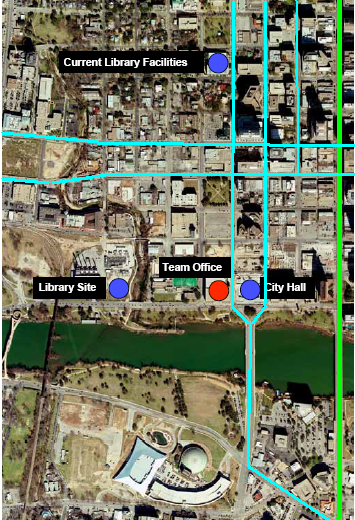
No, there aren’t many buses on Cesar Chavez, especially not over by the new library location – it’s pretty much just the #3, which runs through north central and south Austin.
And, no, for the fifteenth time, there aren’t going to be a lot of shifts in transit routes to come over to the new library. See the body of water to the south? See the lack of bridges farther west than the Guadalupe/Lavaca couplet? Get it?
So what about streetcar, if it ever happens? Problem is that the streetcar line is equivalent to one bus route – the light blue lines on this map are corridors which carry several bus routes that go several different places. If you happen to be among the small part of residential Austin initially served by the streetcar proposal, great, but otherwise you’re looking at a two-leg transit ride to get to the library at best. The yellow line shows the streetcar proposal, if it ever happens, and if it ever makes it across Shoal Creek, the latter question being far more doubtful than the former.
